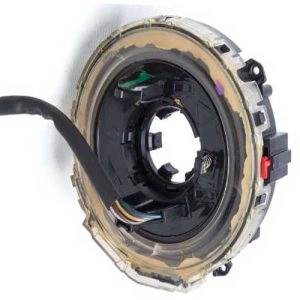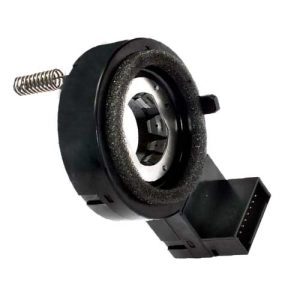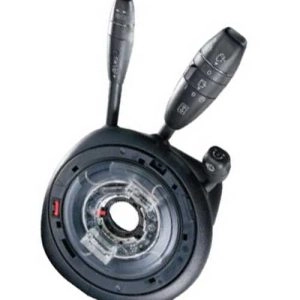The Steering Angle Sensor (SAS) is an indispensable element among the car sensors. Many people don't know its location, but it's directly behind the dashboard, or sometimes below it or above it in some other cars. The function of this sensor is to calculate and estimate the steering angle, so the car's computer can tell whether the car is moving in a straight line or taking a turn and going around a bend.
In addition to the above, the steering sensor plays a significant role in ensuring the traction and stability of the car, as it is linked to the electronic stability technology in the vehicle, which goes by multiple names such as DSC, ESP, ESC, VSA, and others. This sensor sends information and data about the steering wheel rotation speed to the car's computer. This aids in making driving and steering control easier at lower speeds, whereas the steering becomes heftier and more challenging at high speeds, providing better and safer control for the driver.
However, most car sensors do not last for a long time, they break down in a short period and get damaged. The car owner needs to replace them with other sensors. If he does not get rid of the damaged sensors, they might provide him with incorrect values, making driving harder and more dangerous. Therefore, in this article, we will talk about the SAS steering sensor, its types, and the top 3 signs indicating its malfunction and damage.
Types of Steering Sensor in Cars

Generally, there are two types of steering sensors in cars, which are the digital sensor and the analog sensor. Here is a simple comparison between them:
Analog Sensor:This sensor operates to measure the direction angle of the car by altering the electric column while turning the steering wheel.
Digital Sensor:Also known as the digital steering angle sensor, it is the most common and widely used. This sensor relies on a small LED light to determine the rotation angle of the steering wheel, and then transfers the information to the car's computer (electronic control unit).
It's worth noting that there is a difference between the steering wheel chip and the steering sensor, each with its own importance and distinct functions from the other. To replace or inspect them, in most cases, you will likely need to remove the steering wheel.
Also read:How to Adjust Car Mirrors Correctly
Signs of Damage to the Steering Angle Sensor (SAS)

The steering sensor is among the sensors that do not malfunction quickly or require maintenance, replacement, or recalibration after a short period. However, ultimately, it is an electronic component that will eventually undergo damage after a certain period, and you will therefore need to replace it. There are some signs that alert you about the importance of replacing this sensor. Here are three important signs:
Feeling difficulty and heaviness while turning the steering wheel:We mentioned above that the function of the sensor is to monitor the speed of rotation and movement of the steering. It then transfers the data and information to the car's computer. However, if the sensor is damaged, it will give incorrect information and numbers to the computer, leading to an abnormal feeling during the movement and rotation of the steering. This could be sensed as heaviness or lightness during rotation that was not felt before.
This becomes clearly visible when driving at high speeds. If you encounter lightness, heaviness, speed, or slowness in steering, or if it does not function as it should, you should visit the maintenance center as soon as possible in order to inspect the ESP system and check it, resolving the issue without any damages.
Seeing the anti-skid light:The steering sensor is also used in the traction control system to measure and determine the position of the steering wheel and the rate of its rotation. If the sensor is damaged or not functioning, and it doesn't provide accurate information and data, you might see the anti-skid warning light suddenly turn on. You might also see the ABS light, as these systems and devices are interconnected.
Changing the steering wheel sensor angle after balancing the car:The balance of the car is essential for checking the tire contact when driving at the appropriate angle, and ensuring they are directed straight in accordance with the car manufacturer's specifications. This is to provide the best driving experience, the best possible and quiet performance, and extend the service life of the tires.
But what often happens is forgetting to reset the steering sensor after finishing the car alignment, thus giving false values, leading to a change in the steering angle.

It should be noted that the aforementioned signs may not confirm a malfunction or damage to the steering sensor. It might just need to be reset and reprogrammed by a qualified technician. The technician identifies the area of damage or error, then diagnoses the condition and takes appropriate actions to resolve the issue, ensuring the return of the steering sensor to its normal state.
Some problems with the SAS steering sensor.
If the car or engine is subjected to overload, the pressure and weight on the car's tires will increase, leading to malfunctioning.Steering Wheel SensorIf it is of the hydraulic type, but if it is of the electric type, there is no need to worry, as this problem has been solved in this type, and the hydraulic sensor operates through an oil pump connected to the car engine.

Comments